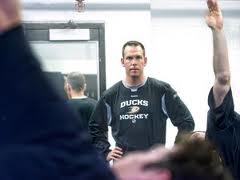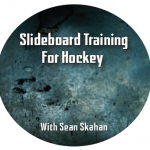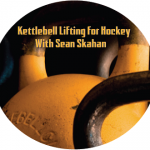Several years ago Eric Cressey introduced me to Sean Skahan, who was then and is still now the Strength and Conditioning Coach for the Anaheim Ducks. Since that first introduction, Sean has been a terrific resource and mentor for me. I recently had an opportunity to borrow some of his time to do an exclusive interview for you. Check it out below!
KN: Sean, I think most of the people reading this will recognize your work from HockeyStrengthandConditioning.com, but why don’t we kick things off by having you tell us a bit about who you are, and the path you took to get where you are.
SK: First off Kevin, thank you for giving me the opportunity to answer your questions. I really appreciate it!
I am a Strength and Conditioning Coach in the National Hockey League. I’ve been employed by the Anaheim Ducks for 10 seasons. I’ve been fortunate to work with an organization for that time. Prior to that, I was a Strength and Conditioning Coach in the collegiate ranks. Most recently, I was an Assistant Strength and Conditioning Coach at Boston College for 1 year where I was responsible for the strength and conditioning program for both the men’s and women’s hockey programs amongst other sports. Before BC, I was an Assistant Strength and Conditioning Coach at the University of North Dakota for 1 year. At North Dakota, I assisted with the hockey program as well as being the Strength and Conditioning Coach for several other sports. Prior to that, I was a Graduate Assistant Strength and Conditioning Coach at the University of Minnesota where I assisted with the hockey program as well as several others. Before that, I was intern at Sports Acceleration North, which would now be considered Mike Boyle Strength and Conditioning.

KN: Having worked with three of the top college hockey programs in the country and now having spent a decade in the NHL, you certainly have an impressive track record. I imagine your training philosophy has evolved over the years. How would you describe your hockey training philosophy currently?
SK: My hockey training philosophy would probably consist of doing whatever it takes to keep my players injury free while also improving their performance. While trying my best to accomplish this, I will do whatever I feel would help them achieve this as effectively as possible. The key is figuring out what each player will need to help them succeed in the safest environment as possible.
KN: The injury prevention component of a quality program is one thing I see a lot of players overlook. What are some of the common training mistakes you see players make before they get to you?
SK: Some of the mistakes I may see that would prohibit players from progressing would include:
KN: Great stuff. It amazes me how many high school players I run into that claim they want to play elite level hockey, but just want to do the same bodybuilding routines their non-hockey buddies are doing.
You recently released two new DVDs, Kettlebell Lifting for Hockey and Slideboard Training for Hockey. Tell us a bit about the DVDs-why you decided to make them, who they’re for, what customers can expect to get from watching them, etc.
SK: Honestly, I wanted to create my own information products, but I really didn’t want to develop an info product just to say I did it. I wanted to develop products on thoughts, philosophies, and equipment that I really believed in.


KN: It seems like kettlebell training is a hot fad right now. As you know, sometimes implement-centric training fads come and go in a few years. Are kettlebells here to stay? How are you using them in your programs?
SK: I really think that kettlebells are here to stay. They have actually been around a real long time and have recently been re-discovered. I think that when more coaches learn that there are some awesome exercises and progressions that can only be done properly with a kettlebell, then they have the best chance to stick.
Honestly, I only use them in my program for a few exercises- swings, goblet squats, get ups, carries, and presses- which includes bottoms up variations.
KN: I was really impressed with the variety of exercises in the slideboard DVD. When I was first introduced to the slideboard as a player, it was only used to closely replicate the skating pattern for conditioning work. Talk to us about how you’re using the slideboard and where you got the ideas for all of the unique exercises in the DVD.
SK: We are using the slideboard for many different reasons. We use them for abdominal/trunk exercises, lower body exercises, and upper body exercises. Where we also spend a great amount of time with it is in the rehab/return to play phase for our injured players. One of my goals in the DVD was to not only show the exercises, but to explain to the viewer why we use each exercise.
Most of the exercises in the DVD, I have seen them somewhere else, while some were just a result of looking for a way to challenge an injured athlete who may have needed a progression to help them get better.
KN: A lot of youth players/parents ask me what equipment they should buy so they can train at home. Naturally, it’s not possible for them to build a fully equipped weight room, but I think your DVDs provide a great framework for how kettlebells and slideboards can be used separately and together to train every major physical quality.
SK: What I think is important to mention is that the slideboard and the kettlebell are 2 different pieces of equipment that are huge parts of my philosophy. I am currently at a point at my career where I know what I need to help train a hockey player. These are 2 different pieces that I feel are absolutely necessary to me for to train a hockey player properly.
KN: Sean, thanks for taking the time to talk to us about hockey training and your new DVDs. Where can people learn more about you and pick up a copy of Kettlebell Lifting for Hockey and Slideboard Training for Hockey?
SK: Thanks for having me. People can check out my site www.SeanSkahan.com. The DVDs are available on the “Products” page there!
To your success,
Kevin Neeld
Please enter your first name and email below to sign up for my FREE Athletic Development and Hockey Training Newsletter!